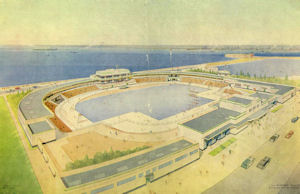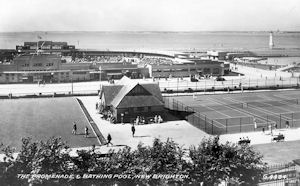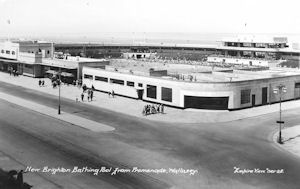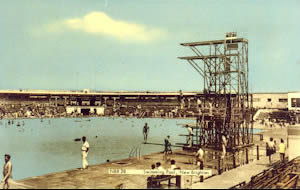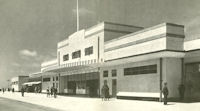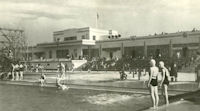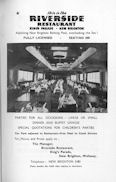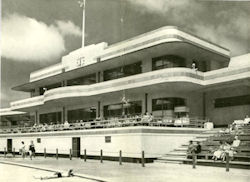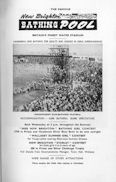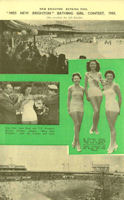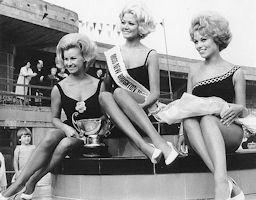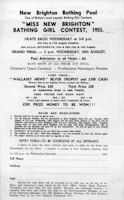On the 13th of June, 1934, before an assembly of nearly 12,000 people, Lord Leverhulme declared open the finest and largest aquatic stadium in the World.
It was only appropriate that Lord Leverhulme should perform the ceremony because his father, William Hesketh Lever, Member of Parliament for the Wirral Division (which at time included Wallasey), laid the foundation stone to commemorate the commencement of the promenade extension from New Brighton to the Marine Lake on 22nd June, 1907.
The popularity of this once magnificent and attractive bathing pool was demonstrated by the fact that no fewer then 100,000 people passed the turnstiles within a week of the opening ceremony. During the first four weeks from the opening date some 350,000 persons paid for admission, of whom 87,400 were bathers, and in early July the Mayor presented a small souvenir to the 500,000th person registering at the turnstiles. During the first 4 months of the opening of the bathing pool almost one million paying customers visited.
The pool was built on sand, covering an area of approximately 4½ acres and cost £103,240. It was constructed of mass concrete, the floor being reinforced with steel mesh. It was covered with a rendering of white Portland cement and a skirting of black tiles. The pool was so designed as to obtain as much sunshine as possible, thus facing south. It was sheltered from the north winds. The exterior walls were coated with Snowcrete, with special fine sand from Leighton Buzzard. Lights which lit up under water were placed at the deep end for night bathing. A 10 metre regulation standard, high diving stage was provided, with immediate stages, suitable for international diving competitions, also separate spring boards, double chutes for adults and children
The pool was designed to allow for Championship swimming events, on the south being 165 feet (32 laps to one mile) by 60 feet. The central part of the Pool for general swimming was 330 feet by 60 feet (16 laps to the mile). The overall measurements of the Pool - 6,500 square feet, 330 feet by 225 feet wide. On the north side the shallow area was 330 feet by 195 feet. The Pool held 4,000 and some 2-,000 spectators. The depth of the Pool had an average of 5 feet, but at the diving end, was 15 feet. The Pool contained 1,376,000 gallons of pure sea water, which could be filled or emptied in eight hours. The Pool was filled through the ornamented cascade. The water was constantly changed and purified, filtered and chemically treated, at a rate of 172,000 gallons per hour. The plant included chemical tanks, aerator, ammoniator, chlorinator, air compressor, and electric motors for the pumps etc. A regular supply of water was obtained from the adjoining Marine Lake, which acted as a huge storage and settlement tank. The total filter area equaled 861 square feet. the rate of filtration was 200 gallons per square foot per hour.
The admission fees were 6d for adults in the week and 1/- on Sundays and Bank Holidays. Children paid 4d and 6d. Non-bathers were charged 2d. The public paid at the main entrance turnstiles, and if wishing to bathe, proceeded round the promenade (which is elevated approximately 9 feet 6 inches above the water level) to the entrances of either ladies' or gentlemen's dressing boxes, where a further payment was made and towels and costumes, if required, obtained.
The main apartments housing the ladies' and gentlemen's dressing boxes were comparatively lofty structures (12 feet 6 inches high) arranged so as to derive the maximum sunlight. while 'Glas-crete' panels inserted in the roof and large horizontal steel windows in the walls gave efficient lighting and ventilation. The dressing boxes were constructed of timber framework, having asbestos sheet divisions with flush paneled doors. The lockers were constructed in two tiers. Again, using asbestos sheet divisions.
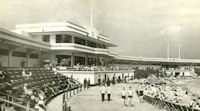 |
 |
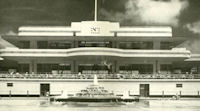 |
New Brighton Baths also included a cafe and kitchen which was situated in a central position between the ladies' and gentlemen's dressing boxes. Access to the cafe was by way of a raised terrace at the dressing box and promenade level. The cafe was a two-storey structure, 90 feet 8 inches long and 37 feet 10 inches in width, of modern design, embodying the use of of concrete balconies and canopies cantilevered out from the main walls. The ground level of the cafe consisted of a large room with wood-block floor, having two double-door openings leading on to a terrace overlooking the bath. At the west end of the cafe, ladies' and gentlemen's toilets were situated, and the east end was a large kitchen which had the stores, larder and the staff messroom and toilets. Communication between the kitchen and the cafe on the first floor was provided by a means of two service lifts. For the public two flight of stairs at the east and west end of the cafe provided the access to the cafe on the first floor.
The sole public access in to New Brighton Bathing Pool was by way of the main entrance block on the south side of the bath. This block consisted of the manager's office, general office, central pay-boxes, turnstiles, messrooms for staff, male and female competitors' changing rooms and was flanked on each side by three shops.
On 10th May, 1937 a large display of Gymnastics was given by Wallasey school children in the empty pool, in celebration of King George VI's Coronation. Over 1,200 pupils took part in the display, which included Country-Dancing.
The first Miss New Brighton Bathing Girl contest started at the Pool in 1949 when the first heat attracted only nine entrants. The following heat saw an increase to 23 entrants. Edna McFarlane won the final, as the rain teamed down, collecting her cup and cheque for £75. 15,000 paid to watch the event. In 1950 Violet Pretty became the holder of the title, she became known to millions as Anne Heywood, the Rank film actress. She entered on a day drip from Birmingham at the age of 18.
Wendy Ann George was Miss New Brighton in 1974. She went on to become Miss Great Britain, as did the Moreton girl, Tracy Dodds (she won the Miss New Brighton under the name Tracy Nielson-Steele in 1977). She was also romantically linked in the early 1980s with the lead singer of Orchestral Manoeuvres In The Dark, Andy McCluskey, from Hoylake.
The first Wallasey girl to win was Joan Boardman in 1960 who went on to win Miss England. Local teacher Hazel Jane Williams, won for Wallasey in 1979, whilst in 1986 20 year Linzi Butler from Moreton won the title. In 1976 the winner of the contest automatically gained entry to Miss British Isles' Contest at Great Yarmouth. Gillian Clark won that year and went on to take the national crown. She came from Raby Mere. She became a dancer and appeared on T.V. The winner received silver trophy. £750 in cash and a sash along with other smaller prizes.
The final was always held in the Bathing Pool regardless of the weather, but in 1981 it was decided if the weather was bad, the event would be transferred to the Floral Pavilion. The last contest was held in 1989 and was won by Jayne Corness of Wavertree.
In May 1984 Granada Television staged a £100,000 Pop Spectacular under the title of "New Brighton Rock" with leading groups taking part such as Eddie Grant, Frankie Goes to Hollywood, Gloria Gaynor, Helen Terry, Madness, Nick Lowe, Nik Kershaw, Spandau Ballet, The Flying Pickets, and the Weather Girls. The show was recorded over 2 days: Monday 21st May and Tuesday 22nd May and was broadcasted on ITV on Saturday 23rd June 1984 at 10.40 pm.
On 26th/27th February 1990, hurricane force winds measuring more then 100 m.p.h caused severe damage to the pool. With costs of more then £4 million to repair the damage it was decided by the authorities to demolish the building. The Merseyside Development Corporation (M.D.C) bulldozed the site in the summer of 1990.
Featured sites
- Non Gamstop Casinos
- Casino Not On Gamstop
- UK Casinos Not On Gamstop
- Non Gamstop Casinos UK
- Sites Not On Gamstop
- Sites Not On Gamstop
- Casinos Not On Gamstop
- Casinos Not On Gamstop
- Casinos Not On Gamstop
- Non Gamstop Casino UK
- Casinos Not On Gamstop
- Non Gamstop Casino
- UK Online Casinos Not On Gamstop
- UK Online Casinos Not On Gamstop
- Non Gamstop Casinos
- Casino Sites Not On Gamstop
- Casinos Not On Gamstop
- Casinos Not On Gamstop
- Best Betting Sites
- Casinos Not On Gamstop
- Gambling Sites Not On Gamstop
- Betting Sites That Are Not On Gamstop
- Non Gamstop Casinos UK
- UK Online Casinos Not On Gamstop
